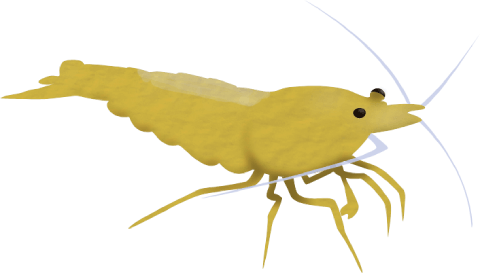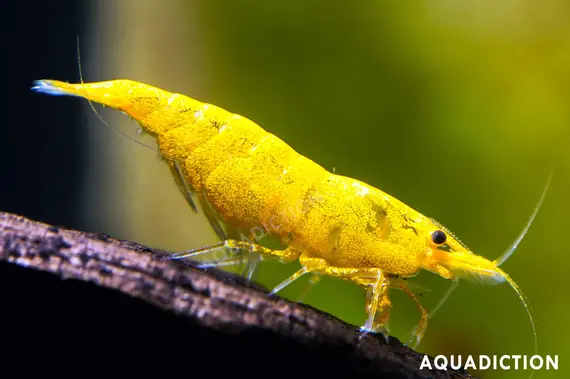Yellow Fire Shrimp can face health issues like bacterial infections and molting problems. Poor water quality can exacerbate these conditions.
Yellow Fire Shrimp, known for their vibrant color, are popular in aquariums. These shrimp, while generally hardy, require specific care to thrive. Proper water quality is crucial for their health. Contaminated water can lead to bacterial infections, which are common health issues.
Ensuring appropriate water parameters and regular tank maintenance can help prevent these problems. Molting issues can also arise if they lack essential nutrients or face stress. Providing a balanced diet and stable environment is key. Regular observation can help catch health problems early, ensuring your Yellow Fire Shrimp remains healthy and active.

Credit: www.shrimpscience.com
Common Health Issues
Yellow Fire Shrimp are popular in aquariums. They are vibrant and active. But they can face health problems. Understanding these issues helps in keeping them healthy.
Parasites
Parasites can affect Yellow Fire Shrimp. They are tiny and hard to see. Common parasites include Vorticella and Scutariella. These can cause stress and illness.
- Vorticella: White growths on the shrimp’s body.
- Scutariella: Small worms on the head or gills.
To treat parasites, use aquarium-safe medications. Ensure to follow the dosage instructions. Regular water changes help prevent infections.
Bacterial Infections
Bacterial infections are common in Yellow Fire Shrimp. They can cause lethargy and loss of appetite. Infected shrimp may have red spots or swollen areas.
| Symptom | Description |
|---|---|
| Red Spots | Small red patches on the body. |
| Swollen Areas | Inflamed or swollen parts of the body. |
Treat bacterial infections with antibiotic treatments. Ensure good water quality to prevent these infections.
Fungal Infections
Fungal infections appear as white or grey patches. These patches can be fluffy or cotton-like. Fungal infections can weaken the shrimp.
- Isolate the infected shrimp.
- Use antifungal treatments.
- Maintain clean water conditions.
Regular tank maintenance is key. This helps prevent fungal infections.
Recognizing Symptoms
Recognizing symptoms of health problems in Yellow Fire Shrimp is crucial. Early detection can help in providing timely treatment. This section will help you identify common signs of distress in your shrimp.
Physical Changes
Physical changes are often the first indicators of health problems. Look for these signs:
- Color Changes: Dull or pale colors can signal illness.
- White Spots: Indicate a fungal or bacterial infection.
- Damaged Appendages: Missing legs or antennae can show signs of stress or predation.
- Swollen Abdomen: May suggest internal parasites or reproductive issues.
Behavioral Changes
Behavioral changes can also indicate health issues in Yellow Fire Shrimp. Watch for these behaviors:
- Lethargy: Reduced activity levels can be a sign of poor health.
- Erratic Swimming: Uncoordinated movements may indicate neurological problems.
- Hiding More Often: Increased hiding can signal stress or fear.
- Refusal to Eat: Loss of appetite is a major red flag.
Prevention Strategies
Yellow Fire Shrimp are delicate creatures that require special care. Proper prevention strategies can help avoid health problems. Focus on water quality and tank maintenance to keep them healthy.
Water Quality
Maintaining optimal water quality is crucial for Yellow Fire Shrimp health. Here are some tips:
- Keep the water temperature between 72°F and 82°F.
- Ensure the pH level stays between 6.5 and 7.5.
- Use a high-quality water filter to remove impurities.
- Check ammonia, nitrite, and nitrate levels weekly.
- Perform regular water changes to maintain cleanliness.
Tank Maintenance
Proper tank maintenance is essential to prevent health issues. Follow these steps:
- Clean the tank walls and substrate regularly.
- Remove uneaten food to avoid contamination.
- Inspect the filter and replace it as needed.
- Ensure all tank equipment is functioning correctly.
- Quarantine new shrimp before adding them to the tank.
By focusing on water quality and tank maintenance, you can prevent many health problems. Keep your Yellow Fire Shrimp happy and healthy with these simple steps.
Proper Nutrition
Proper nutrition is vital for maintaining the health of your Yellow Fire Shrimp. A balanced diet ensures they stay active, vibrant, and disease-free. Below, you’ll find essential guidelines on providing the right nutrition for your shrimp.
Diet Essentials
Yellow Fire Shrimp need a variety of foods to stay healthy. Their diet should include:
- High-quality shrimp pellets: These should be the staple food.
- Algae wafers: Offer these to provide essential nutrients.
- Blanched vegetables: Feed them spinach, zucchini, or peas.
- Protein sources: Include bloodworms or brine shrimp occasionally.
These food items ensure they get all necessary vitamins and minerals. A diverse diet promotes strong immune systems and vibrant colors.
Avoiding Overfeeding
Overfeeding can lead to several health problems in Yellow Fire Shrimp. It’s crucial to feed them the right amount. Follow these guidelines:
- Feed small amounts twice a day.
- Remove uneaten food within 2 hours.
- Offer only as much food as they can eat in 2-3 minutes.
Overfeeding can cause water pollution and shrimp health issues. Stick to the feeding schedule and amounts to maintain a healthy environment.
Quarantine Procedures
Quarantining Yellow Fire Shrimp is essential for their health. This process helps to prevent diseases from spreading to other tank inhabitants. Let’s dive into the steps involved in setting up a quarantine tank and monitoring the shrimp during the quarantine period.
Setting Up Quarantine Tank
Setting up a quarantine tank is the first step. Follow these steps to ensure a safe environment for your shrimp:
- Choose a small tank: A 10-gallon tank is ideal.
- Use a sponge filter: It provides gentle filtration.
- Maintain water parameters: Keep the water temperature between 72-78°F. Ensure pH levels are between 7.0-8.0.
- Add hiding spots: Use PVC pipes or small caves.
- Use separate equipment: Avoid cross-contamination with the main tank.
Duration And Monitoring
The quarantine period should last for a minimum of two weeks. During this time, closely monitor the shrimp for any signs of illness.
- Observe behavior: Look for lethargy or unusual swimming patterns.
- Check for physical signs: Watch for discoloration or spots.
- Maintain water quality: Perform regular water changes to keep the environment clean.
- Monitor feeding: Ensure they are eating well. Use high-quality shrimp food.
By following these quarantine procedures, you can keep your Yellow Fire Shrimp healthy and thriving.
Treatment Options
Yellow Fire Shrimp health problems can be stressful for any shrimp keeper. Knowing the right treatment options is essential for maintaining a healthy tank. This section will explore various treatment methods, including medications and natural remedies.
Medications
Using medications can be effective for treating Yellow Fire Shrimp health problems. Some common medications include:
- Antibiotics: Useful for bacterial infections. Follow dosage instructions carefully.
- Anti-fungal treatments: Necessary for fungal infections. Always read the label.
- Anti-parasitic medications: Effective against parasites. Use sparingly and monitor shrimp closely.
Always quarantine new shrimp before adding them to your main tank. This helps prevent the spread of diseases.
Natural Remedies
Some shrimp keepers prefer natural remedies for treating health issues. These methods are often safer and less stressful for shrimp:
- Garlic: Acts as a natural antibiotic. Crush a small piece and add it to the tank.
- Indian Almond Leaves: Releases beneficial tannins. Helps improve water quality and shrimp health.
- Salt baths: Effective for treating parasites. Use a separate container with a mild salt solution.
Regular water changes and maintaining proper tank conditions are crucial. These steps help keep your shrimp healthy and reduce the risk of disease.
Stress Management
Stress management is crucial for the health of Yellow Fire Shrimp. Stress can weaken their immune system and make them susceptible to diseases. Here, we explore how to manage stress effectively.
Ideal Tank Conditions
Providing the ideal tank conditions ensures your shrimp remain healthy and stress-free. Follow these guidelines for optimal tank setup:
- Water Temperature: Maintain a temperature between 72°F and 82°F.
- pH Level: Keep the pH between 6.5 and 8.0.
- Ammonia Levels: Ensure ammonia levels are at 0 ppm.
- Nitrite Levels: Keep nitrite levels at 0 ppm.
- Nitrate Levels: Maintain nitrates below 20 ppm.
Stable water conditions reduce stress and promote shrimp health.
Minimizing Aggression
Aggression can cause significant stress for Yellow Fire Shrimp. Here are ways to minimize aggression in your tank:
| Method | Description |
|---|---|
| Proper Stocking | Do not overcrowd the tank. Follow the one shrimp per 2 gallons rule. |
| Hiding Spots | Add plenty of hiding spots like rocks and plants. |
| Tank Mates | Select peaceful tank mates that will not harass the shrimp. |
Reducing aggression helps create a peaceful environment for your shrimp.

Credit: saturnshrimp.co.za
Regular Check-ups
Regular check-ups are crucial for maintaining the health of your Yellow Fire Shrimp. These tiny creatures need consistent monitoring to thrive in their environment. Regular check-ups help identify potential health problems early, ensuring your shrimp live a long, healthy life.
Routine Observations
Observing your Yellow Fire Shrimp daily is essential. Watch their behavior and activity levels. Healthy shrimp are active and responsive. If you notice any changes, it might indicate a health problem.
- Check for consistent eating habits.
- Observe their color and shell condition.
- Look for signs of stress or lethargy.
- Monitor their interaction with other tank mates.
| Sign | Indication |
|---|---|
| Color Fading | Possible illness or stress |
| Slow Movement | Potential health issue |
| Loss of Appetite | May indicate disease |
Professional Consultations
Consult a professional if you notice any unusual signs. A vet specializing in aquatic animals can provide valuable insights. They can diagnose and treat potential health problems.
- Collect all relevant information about your shrimp’s behavior.
- Take note of water conditions and recent changes.
- Provide a detailed history to the vet.
- Follow the vet’s recommendations carefully.
Regular professional consultations can prevent serious health issues. They ensure your Yellow Fire Shrimp remain healthy and vibrant.

Credit: aquadiction.world
Frequently Asked Questions
Is Yellow Shrimp Ok?
Yes, yellow shrimp are safe to eat if they are fresh and properly cooked. Ensure they are sourced from reputable suppliers.
How Can You Tell If Shrimp Are Sick?
Sick shrimp show signs like lethargy, loss of appetite, discolored or cloudy shells, and abnormal swimming behavior. Check for white spots or unusual growths.
What Are The Symptoms Of Yellow Head Disease In Shrimp?
Shrimp with yellow head disease show a pale yellowish cephalothorax, reduced feed intake, slow growth, and lethargy. They may also exhibit a swollen hepatopancreas and increased mortality rates.
How To Treat Yellow Fungus On Shrimp?
Treat yellow fungus on shrimp by isolating affected shrimp, improving water quality, and using antifungal treatments. Maintain optimal tank conditions.
Conclusion
Maintaining the health of your Yellow Fire Shrimp is crucial. Regular water changes and proper diet can prevent many issues. Observing their behavior will help you catch problems early. A healthy tank environment ensures your shrimp thrive. Follow these tips to keep your Yellow Fire Shrimp happy and healthy.
